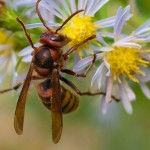
How to get rid of Hornets?
Inspection and identification is the first and foremost step in getting pest problems under control.
Dolichovespula maculata, the baldfaced hornet resembles a larger version of a common yellowjacket, except they have whitish-colored facial, thoracic, and abdominal markings. The queen is the largest member of the colony. Baldfaced hornets build their gray, rounded, paper-like nests above ground on tree branches, thick bushes, or in tree hollows.
The most obvious signs of a hornet problem are presence of adults and the observance of nests. While sometimes possible, it usually isn’t wise to attempt any do-it-yourself efforts for hornet control. However, should you decide to attempt to destroy a hornet’s nest on your own, do so only after dark when most or all of the colony members have returned to the nest. Typical symptoms and reactions to stings by hornets are intense pain, redness and swelling around the site of the sting. When someone is stung multiple times or is highly allergic to the insect’s venom, there can be systemic reactions that may affect the entire body.
It is recommended that anyone experiencing a infestation contact a pest control professional to arrange for a consultation. Professionals are trained not only to address current infestations but also to prevent future infestations. Scheduling a home inspection is free and it will save you time and money.
HORNETS
PEST CONTROL
The adult European Hornet is approximately 1-1.5 inches long and has two pairs of wings and six legs. Its head, thorax, first abdominal segment and legs are reddish-brown. The queen is the largest member of the hornet colony. European hornets are not as aggressive as baldfaced hornets, but will nevertheless sting if their colony is disturbed. European hornets tend to make their nests in secluded, aboveground locations such hollow trees, attics, porches and inside wall voids.
Hornets aggressively guard their nest when threatened and even more so when they are close to human habitation. Their stings are more painful than typical wasp stings because hornet venom contains a large amount of acetylcholine. The toxicity can be typical or be the most venomous know insect.
Hornets build communal nests by chewing wood to make a papery pulp. Each nest has one queen, who lays eggs and is attended by workers. Most species make exposed nests in trees and shrubs. Children should not be allowed to throw objects at the nests. Unlike honeybees, bald-faced hornets are capable of stinging repeatedly.
Our trained professional will create a tailored solution for your home or commercial needs.
Your Carefree technician can come periodically to monitor your home and help prevent an infestation with HORNETS.
30 DAYS MONEY BACK GUARANTEE
We accept all credit and debit cards!
our TESTIMONIALS
